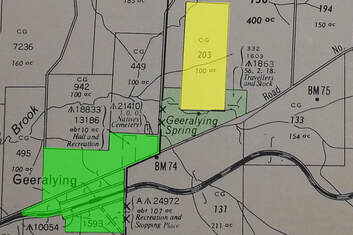 Green=reserve, pale green former reserve, yellow Cowcher home block
Green=reserve, pale green former reserve, yellow Cowcher home block Greetings fellow Foxies,
Geeralying Reserve is a patch of sheoak wandoo woodland that once surrounded Gearlin/Geeralying Spring. The spring was an important permanent water supply which, with Kunderning Pool to the south and Kondenning Pool at Bannister to the west was an essential water supply along travel routes for the Noongar people, then sandalwood cutters, shepherds and early settlers.
Stanyford Cowcher a grazier who shepherded sheep between Pinjarra and Williams, established a homestead farm north of the spring in 1893.
In 1897, William Lefevre Graham, selected a property on the south east side of the reserve.
In 1906 the Narrogin-Williams railway was built with a siding on the south side of the reserve. Unfortunately for the Graham family, the railway passed right through the home orchard and they decided to move house further south.
Geeralying Reserve is a patch of sheoak wandoo woodland that once surrounded Gearlin/Geeralying Spring. The spring was an important permanent water supply which, with Kunderning Pool to the south and Kondenning Pool at Bannister to the west was an essential water supply along travel routes for the Noongar people, then sandalwood cutters, shepherds and early settlers.
Stanyford Cowcher a grazier who shepherded sheep between Pinjarra and Williams, established a homestead farm north of the spring in 1893.
In 1897, William Lefevre Graham, selected a property on the south east side of the reserve.
In 1906 the Narrogin-Williams railway was built with a siding on the south side of the reserve. Unfortunately for the Graham family, the railway passed right through the home orchard and they decided to move house further south.

Other farmers established farms in the area and a one-teacher school was built on the Graham property adjoining Manaring Road in 1916. The school was ‘the canvas, sliding shutter type, airy in summer and more airy in winter’ (The Way Through p287). Contrast that with what we have now!
A hall and a tennis court were also built on the reserve but nothing remains of all three except a few plaques.
Over the years, Stanyford’s son Thomas (Tom) Spurling Cowcher, bought out adjoining farms, and part of the reserve east of Cowcher Road.
A hall and a tennis court were also built on the reserve but nothing remains of all three except a few plaques.
Over the years, Stanyford’s son Thomas (Tom) Spurling Cowcher, bought out adjoining farms, and part of the reserve east of Cowcher Road.
There was a significant Aboriginal population in the reserve until changes initiated by the 1967 referendum that gave the Commonwealth government sole powers for Aboriginal-related legislation. Wendy Mcdonald,( a Cowcher before marriage) recalls numerous families living in humpys on the reserve.
According to Stuart Graham, the Ugle family group moved to Geeralying Reserve from Beverley in 1922 to work as shearers and farm workers.
A small fenced area to the north/north-west of the bush is all that remains of an aboriginal cemetery. Apparently the cemetery contains numerous still-born and young babies, two ‘Feather Feet’ (these were aboriginal spirit men/witchdoctors who did not belong to any clan), and Lyla Ugle.
Two vacant asbestos houses on reserve land adjoining Tom Cowcher’s house were apparently built by Tom for aboriginal shearers. I think that the one that contains evidence of relatively recent occupation was the home of John and Lyla Ugle. When Lyla died, John was granted permission to have her buried in the cemetery plot opposite his house so he could see her grave when he got up each morning. He was the last occupant of the reserve to my knowledge. Other inhabitants include Neddy Isaacs and Shirley Hume.
According to Stuart Graham, the Ugle family group moved to Geeralying Reserve from Beverley in 1922 to work as shearers and farm workers.
A small fenced area to the north/north-west of the bush is all that remains of an aboriginal cemetery. Apparently the cemetery contains numerous still-born and young babies, two ‘Feather Feet’ (these were aboriginal spirit men/witchdoctors who did not belong to any clan), and Lyla Ugle.
Two vacant asbestos houses on reserve land adjoining Tom Cowcher’s house were apparently built by Tom for aboriginal shearers. I think that the one that contains evidence of relatively recent occupation was the home of John and Lyla Ugle. When Lyla died, John was granted permission to have her buried in the cemetery plot opposite his house so he could see her grave when he got up each morning. He was the last occupant of the reserve to my knowledge. Other inhabitants include Neddy Isaacs and Shirley Hume.
| August 2022 I had dismissed the nature value of Geeralying reserve because it has been very disturbed and weedy, but was amazed to find a patch of orchids near the parking bay. I discovered the (uncommon) blood spider orchid and cowslip, jug, snail and dark banded greenhood orchids. For a visual exploration of the reserve and house see this Google Photo album Click individual images for information |



